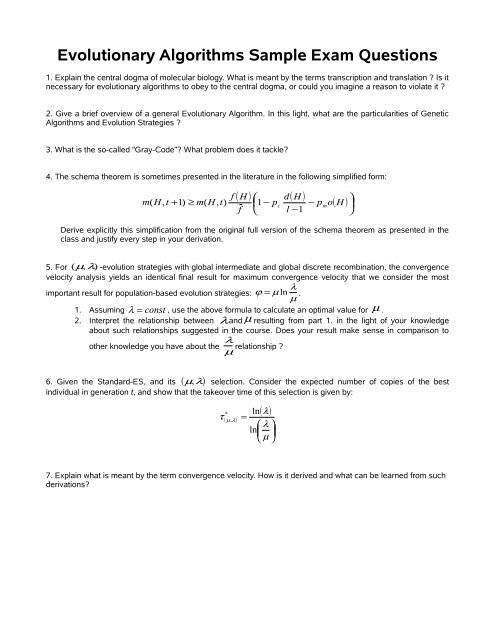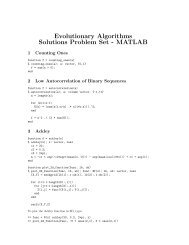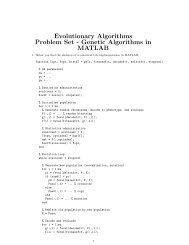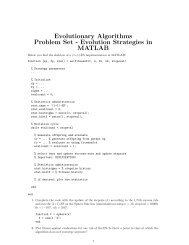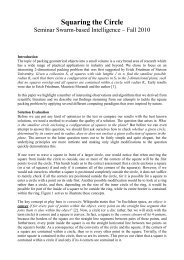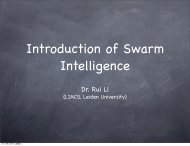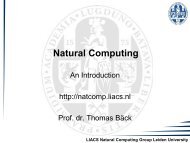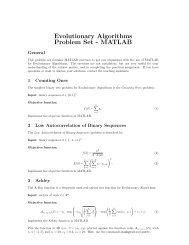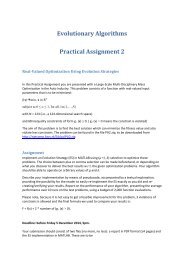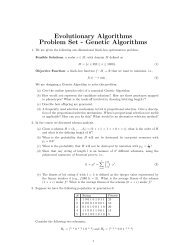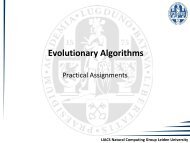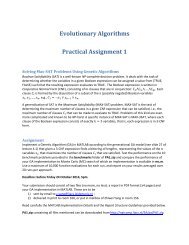Evolutionary Algorithms Sample Exam Questions
Evolutionary Algorithms Sample Exam Questions
Evolutionary Algorithms Sample Exam Questions
You also want an ePaper? Increase the reach of your titles
YUMPU automatically turns print PDFs into web optimized ePapers that Google loves.
<strong>Evolutionary</strong> <strong>Algorithms</strong> <strong>Sample</strong> <strong>Exam</strong> <strong>Questions</strong><br />
1. Explain the central dogma of molecular biology. What is meant by the terms transcription and translation ? Is it<br />
necessary for evolutionary algorithms to obey to the central dogma, or could you imagine a reason to violate it ?<br />
2. Give a brief overview of a general <strong>Evolutionary</strong> Algorithm. In this light, what are the particularities of Genetic<br />
<strong>Algorithms</strong> and Evolution Strategies ?<br />
3. What is the so-called “Gray-Code”? What problem does it tackle?<br />
4. The schema theorem is sometimes presented in the literature in the following simplified form:<br />
( H ) d ( H )<br />
f ⎛<br />
⎞<br />
m(<br />
H,<br />
t + 1) ≥ m(<br />
H,<br />
t)<br />
⎜1<br />
− pc<br />
− pmo( H )⎟<br />
f ⎝ l −1<br />
⎠<br />
Derive explicitly this simplification from the original full version of the schema theorem as presented in the<br />
class and justify every step in your derivation.<br />
5. For ( µ , λ)<br />
-evolution strategies with global intermediate and global discrete recombination, the convergence<br />
velocity analysis yields an identical final result for maximum convergence velocity that we consider the most<br />
λ<br />
important result for population-based evolution strategies: ϕ = µ ln .<br />
µ<br />
1. Assuming λ = const , use the above formula to calculate an optimal value for µ .<br />
2. Interpret the relationship between λand µ resulting from part 1. in the light of your knowledge<br />
about such relationships suggested in the course. Does your result make sense in comparison to<br />
other knowledge you have about the µ<br />
λ relationship ?<br />
µ, λ selection. Consider the expected number of copies of the best<br />
individual in generation t, and show that the takeover time of this selection is given by:<br />
6. Given the Standard-ES, and its ( )<br />
( λ)<br />
* ln<br />
τ ( µ , λ ) =<br />
⎛ λ ⎞<br />
ln⎜<br />
⎟<br />
⎝ µ ⎠<br />
7. Explain what is meant by the term convergence velocity. How is it derived and what can be learned from such<br />
derivations?
8. Consider an individual in an Evolution Strategy with the structure<br />
(<br />
4<br />
x1,<br />
x2<br />
, x3,<br />
x , Σ)<br />
where Σ denotes the representation of the covariance matrix as used by the Evolution Strategy for the general<br />
case. Consider the following matrices:<br />
Σ<br />
1<br />
⎛1<br />
⎜<br />
⎜0<br />
= ⎜0<br />
⎜<br />
⎝0<br />
0<br />
1<br />
0<br />
0<br />
0<br />
0<br />
0.1<br />
0<br />
0⎞<br />
⎟<br />
0⎟<br />
⎟,<br />
0<br />
⎟<br />
1<br />
⎠<br />
Σ<br />
2<br />
⎛ 2<br />
⎜<br />
⎜ 0<br />
= ⎜ 0<br />
⎜<br />
⎝0.7<br />
0<br />
1<br />
3.1<br />
0<br />
0<br />
3.1<br />
10<br />
0<br />
0.7⎞<br />
⎟<br />
0 ⎟<br />
⎟,<br />
0<br />
⎟<br />
1<br />
⎠<br />
Σ<br />
3<br />
⎛ 1<br />
⎜<br />
⎜0.25<br />
= ⎜ 1<br />
⎜<br />
⎝ 1<br />
0.25<br />
1<br />
0<br />
0<br />
1<br />
0<br />
1<br />
0<br />
1⎞<br />
⎟<br />
0⎟<br />
0⎟<br />
⎟<br />
1<br />
⎠<br />
1. Assuming that those matrices describe the actual distribution of the decision parameters to be<br />
optimized, what information can you retrieve from them about those variables? Write explicitly all the<br />
available information for the 3 cases.<br />
2. How can a diagonalization of the given matrices contribute to the search, if at all? Explain your<br />
answer for the 3 different cases, and consider the eigenvalues as well as the eigenvectors in your<br />
argumentation.<br />
9. Consider the well-known NP-complete combinatorial optimization problem, the 0/1 Multiple Knapsack<br />
Problem, posed as follows:<br />
A thief robbing a store finds N objects. He has M different knapsacks of capacities. Each one of the N<br />
items has a value in Euros and a weight. The thief would like to take as valuable a load as possible,<br />
without overfilling the bags. What items should he take? MCC...,,1iviw<br />
1. Develop a representation of solution candidates.<br />
2. Propose an objective function for the given optimization problem.<br />
3. Propose an <strong>Evolutionary</strong> Algorithm for solving the given problem. Explain briefly the behaviour of the<br />
various operators in your algorithm.


